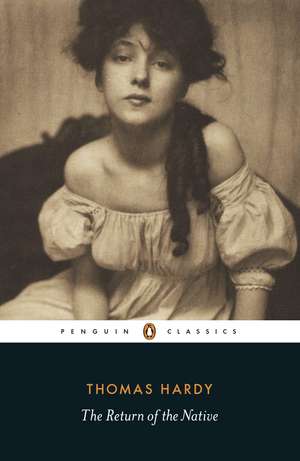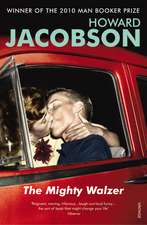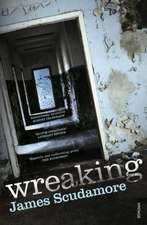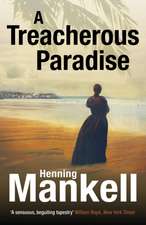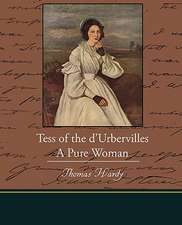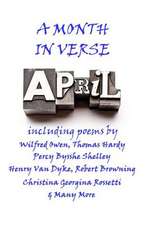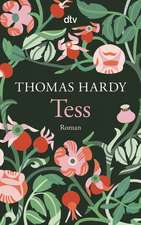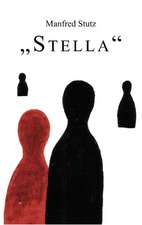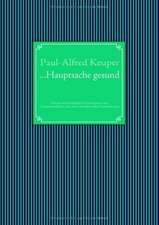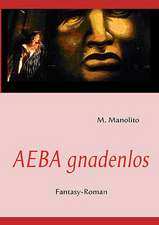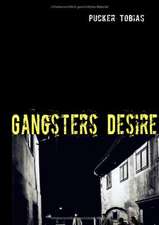The Return of the Native
Autor Thomas Hardy Editat de Tony Slade Introducere de Penny Boumelha Prefață de Patricia Inghamen Limba Engleză Paperback – 23 iun 1999
Against the lowering background of Egdon Heath, fiery Eustacia Vye passes her days, wishing only for passionate love. She believes that her escape from Egdon lies in marriage to Clym Yeobright, home from Paris and discontented with his work there. But Clym wishes to return to the Egdon community; a desire which sets him in opposition to his wife and brings them both to despair.
Based on the first edition of the text, this edition includes detailed notes of later revisions made by Hardy, glossary, bibliography and useful chronology of author's life. In her introduction Penny Bouhmelha identifies the literary and classical allusions in Hardy's text, in particular the parallels with Flaubert'sMadame Bovaryand with the Oedipus story. In so doing she demonstrates Hardy's claim for tragic status for ordinary human lives and the ways that the characters in the novel - especially the ill-fated lovers and Damon Wildeve - spoil their chances to master their own destinies.
Thomas Hardy (1840-1928), born Higher Brockhampton, near Dorchester, originally trained as an architect before earning his living as a writer. Though he saw himself primarily as a poet, Hardy was the author of some of the late eighteenth century's major novels:The Mayor of Casterbridge(1886),Tess of the D'Urbervilles(1891),Far from the Madding Crowd(1874), andJude the Obscure(1895). Amidst the controversy caused byJude the Obscure, he turned to the poetry he had been writing all his life. In the next thirty years he published over nine hundred poems and his epic drama in verse,The Dynasts.
If you enjoyedThe Return of the Native, you might like Anne Brontë'sThe Tenant of Wildfell Hall, also available in Penguin Classics.
'The greatest tragic writer among the English novelists'
Virginia Woolf
| Toate formatele și edițiile | Preț | Express |
|---|---|---|
| Paperback (31) | 39.38 lei 3-5 săpt. | |
| Bantam Classics – 31 ian 1982 | 39.38 lei 3-5 săpt. | |
| Vintage Publishing – 3 iun 2010 | 46.26 lei 24-30 zile | +21.54 lei 5-11 zile |
| Penguin Books – 23 iun 1999 | 50.73 lei 24-30 zile | +22.02 lei 5-11 zile |
| Oxford University Press – 14 aug 2008 | 50.73 lei 10-16 zile | +22.02 lei 5-11 zile |
| CREATESPACE – | 64.23 lei 3-5 săpt. | |
| CREATESPACE – | 79.17 lei 3-5 săpt. | |
| CREATESPACE – | 90.39 lei 3-5 săpt. | |
| CREATESPACE – | 92.33 lei 3-5 săpt. | |
| – | 97.26 lei 3-5 săpt. | |
| – | 124.64 lei 3-5 săpt. | |
| CreateSpace Independent Publishing Platform – | 125.11 lei 3-5 săpt. | |
| CREATESPACE – | 135.15 lei 3-5 săpt. | |
| – | 142.35 lei 3-5 săpt. | |
| CREATESPACE – | 142.70 lei 3-5 săpt. | |
| CHIZINE PUBN – 25 mai 2017 | 214.31 lei 17-23 zile | +19.89 lei 5-11 zile |
| CreateSpace Independent Publishing Platform – | 84.88 lei 6-8 săpt. | |
| KUPERARD (BRAVO LTD) – 22 mar 2001 | 90.35 lei 6-8 săpt. | |
| Digireads.com – 8 iun 2018 | 100.78 lei 6-8 săpt. | |
| – | 119.39 lei 6-8 săpt. | |
| SMK Books – 5 ian 2012 | 127.01 lei 6-8 săpt. | |
| Crescent Moon Publishing – 18 mai 2020 | 131.65 lei 6-8 săpt. | |
| SC Active Business Development SRL – 29 noi 2017 | 145.15 lei 38-44 zile | |
| Aegypan Press – 31 dec 2006 | 145.38 lei 6-8 săpt. | |
| TREDITION CLASSICS – 30 noi 2011 | 154.90 lei 38-44 zile | |
| CreateSpace Independent Publishing Platform – 3 dec 2015 | 200.95 lei 6-8 săpt. | |
| Simon & Brown – 30 oct 2018 | 203.68 lei 38-44 zile | |
| Simon & Brown – 15 noi 2018 | 218.26 lei 38-44 zile | |
| Maven Books – iul 2023 | 221.09 lei 6-8 săpt. | |
| Echo Library – 30 iun 2003 | 230.76 lei 38-44 zile | |
| Echo Library – 31 mar 2006 | 262.61 lei 38-44 zile | |
| TREDITION CLASSICS – 31 oct 2011 | 263.95 lei 6-8 săpt. | |
| Hardback (5) | 85.00 lei 24-30 zile | +37.40 lei 5-11 zile |
| EVERYMAN – 8 oct 1992 | 85.00 lei 24-30 zile | +37.40 lei 5-11 zile |
| Cambridge University Press – 24 feb 2021 | 808.62 lei 3-5 săpt. | |
| SMK Books – 3 apr 2018 | 241.00 lei 6-8 săpt. | |
| Simon & Brown – 30 oct 2018 | 256.82 lei 38-44 zile | |
| Simon & Brown – 15 noi 2018 | 273.15 lei 38-44 zile |
Preț: 50.73 lei
Preț vechi: 58.75 lei
-14% Nou
Puncte Express: 76
Preț estimativ în valută:
9.71€ • 10.10$ • 8.01£
9.71€ • 10.10$ • 8.01£
Carte disponibilă
Livrare economică 27 martie-02 aprilie
Livrare express 08-14 martie pentru 32.01 lei
Preluare comenzi: 021 569.72.76
Specificații
ISBN-13: 9780140435184
ISBN-10: 0140435182
Pagini: 496
Ilustrații: Illustrations, maps
Dimensiuni: 138 x 199 x 23 mm
Greutate: 0.34 kg
Editura: Penguin Books
Colecția Penguin Classics
Locul publicării:London, United Kingdom
ISBN-10: 0140435182
Pagini: 496
Ilustrații: Illustrations, maps
Dimensiuni: 138 x 199 x 23 mm
Greutate: 0.34 kg
Editura: Penguin Books
Colecția Penguin Classics
Locul publicării:London, United Kingdom
Notă biografică
Thomas
Hardy
(1840-1928)
was
a
prolific
novelist
and
poet
whose
works
include
'Tess
of
the
D'Urbervilles'
and
'Jude
the
Obscure'.
Penny Bouhmelha is Professor of English at the University of Adelaide and has published work on Hardy and women.
Penny Bouhmelha is Professor of English at the University of Adelaide and has published work on Hardy and women.
Extras
A SATURDAY afternoon in November was approaching the time of twilight, and the vast tract of unenclosed wild known as Egdon Heath embrowned itself moment by moment. Overhead the hollow stretch of whitish cloud shutting out the sky was as a tent which had the whole heath for its floor.
The heaven being spread with this pallid screen and the earth with the darkest vegetation, their meeting-line at the horizon was clearly marked. In such contrast the heath wore the appearance of an instalment of night which had taken up its place before its astronomical hour was come: darkness had to a great extent arrived hereon, while day stood distinct in the sky. Looking upwards, a furze-cutter would have been inclined to continue work; looking down, he would have decided to finish his faggot and go home. The distant rims of the world and of the firmament seemed to be a division in time no less than a division in matter. The face of the heath by its mere complexion added half an hour to evening; it could in like manner retard the dawn, sadden noon, anticipate the frowning of storms scarcely generated, and intensify the opacity of a moonless midnight to a cause of shaking dread.
In fact, precisely at this transitional point of its nightly roll into darkness the great and particular glory of the Egdon waste began, and nobody could be said to understand the heath who had not been there at such a time. It could best be felt when it could not clearly be seen, its complete effect and explanation lying in this and the succeeding hours before the next dawn: then, and only then, did it tell its true tale. The spot was, indeed, a near relation of night, and when night showed itself an apparent tendency to gravitate together could be perceived in its shades and the scene. The sombre stretch of rounds and hollows seemed to rise and meet the evening gloom in pure sympathy, the heath exhaling darkness as rapidly as the heavens precipitated it. And so the obscurity in the air and the obscurity in the land closed together in a black fraternization towards which each advanced half-way.
The place became full of a watchful intentness now; for when other things sank brooding to sleep the heath appeared slowly to awake and listen. Every night its Titanic form seemed to await something; but it had waited thus, unmoved, during so many centuries, through the crises of so many things, that it could only be imagined to await one last crisis—the final overthrow.
The heaven being spread with this pallid screen and the earth with the darkest vegetation, their meeting-line at the horizon was clearly marked. In such contrast the heath wore the appearance of an instalment of night which had taken up its place before its astronomical hour was come: darkness had to a great extent arrived hereon, while day stood distinct in the sky. Looking upwards, a furze-cutter would have been inclined to continue work; looking down, he would have decided to finish his faggot and go home. The distant rims of the world and of the firmament seemed to be a division in time no less than a division in matter. The face of the heath by its mere complexion added half an hour to evening; it could in like manner retard the dawn, sadden noon, anticipate the frowning of storms scarcely generated, and intensify the opacity of a moonless midnight to a cause of shaking dread.
In fact, precisely at this transitional point of its nightly roll into darkness the great and particular glory of the Egdon waste began, and nobody could be said to understand the heath who had not been there at such a time. It could best be felt when it could not clearly be seen, its complete effect and explanation lying in this and the succeeding hours before the next dawn: then, and only then, did it tell its true tale. The spot was, indeed, a near relation of night, and when night showed itself an apparent tendency to gravitate together could be perceived in its shades and the scene. The sombre stretch of rounds and hollows seemed to rise and meet the evening gloom in pure sympathy, the heath exhaling darkness as rapidly as the heavens precipitated it. And so the obscurity in the air and the obscurity in the land closed together in a black fraternization towards which each advanced half-way.
The place became full of a watchful intentness now; for when other things sank brooding to sleep the heath appeared slowly to awake and listen. Every night its Titanic form seemed to await something; but it had waited thus, unmoved, during so many centuries, through the crises of so many things, that it could only be imagined to await one last crisis—the final overthrow.
Recenzii
"Throbs with a very Victorian sense of geologies, pre-histories and even astronomy; you can feel the planet moving under the feet."
--Daily Telegraph
"Inimitably brooding style."
--The Times
"Besides my complete identification with its heroine, I loved the sheer relentless power of the writing. What other writer would start a novel with six solid pages of description without introducing a single character? Like D H Lawrence, Hardy isn't to everyone's taste: too much blighted love and atheistic pessimism. To me, ensconced in a convent thick with incense, confession and church twice on Sundays, a little atheistic pessimism was a welcome antidote."
--Maeve Haran, Independent
"Throbs with a very Victorian sense of geologies, pre-histories and even astronomy; you can feel the planet moving under the feet" Daily Telegraph "Inimitably brooding style" The Times "Besides my complete identification with its heroine, I loved the sheer relentless power of the writing. What other writer would start a novel with six solid pages of description without introducing a single character? Like D H Lawrence, Hardy isn't to everyone's taste: too much blighted love and atheistic pessimism. To me, ensconced in a convent thick with incense, confession and church twice on Sundays, a little atheistic pessimism was a welcome antidote" -- Maeve Haran, Independent "Splendid" Daily Telegraph "Most of Hardy's novels, and particularly the early ones, have a Shakespearean power of creating a unique world and climate of being ... The Return of the Native is ... thoughtful, valedictory, poetic, tinged with the somberness of an uncertainty which seems to well up from the depths of the author's own subconscious ... Hardy's sense of the tragic life of human beings, mere small fragments of consciousness in a vast uncaring universe, comes directly from his own youthful awareness of the place and circumstances described in the novel" -- John Bayley
--Daily Telegraph
"Inimitably brooding style."
--The Times
"Besides my complete identification with its heroine, I loved the sheer relentless power of the writing. What other writer would start a novel with six solid pages of description without introducing a single character? Like D H Lawrence, Hardy isn't to everyone's taste: too much blighted love and atheistic pessimism. To me, ensconced in a convent thick with incense, confession and church twice on Sundays, a little atheistic pessimism was a welcome antidote."
--Maeve Haran, Independent
"Throbs with a very Victorian sense of geologies, pre-histories and even astronomy; you can feel the planet moving under the feet" Daily Telegraph "Inimitably brooding style" The Times "Besides my complete identification with its heroine, I loved the sheer relentless power of the writing. What other writer would start a novel with six solid pages of description without introducing a single character? Like D H Lawrence, Hardy isn't to everyone's taste: too much blighted love and atheistic pessimism. To me, ensconced in a convent thick with incense, confession and church twice on Sundays, a little atheistic pessimism was a welcome antidote" -- Maeve Haran, Independent "Splendid" Daily Telegraph "Most of Hardy's novels, and particularly the early ones, have a Shakespearean power of creating a unique world and climate of being ... The Return of the Native is ... thoughtful, valedictory, poetic, tinged with the somberness of an uncertainty which seems to well up from the depths of the author's own subconscious ... Hardy's sense of the tragic life of human beings, mere small fragments of consciousness in a vast uncaring universe, comes directly from his own youthful awareness of the place and circumstances described in the novel" -- John Bayley
Descriere
Descriere de la o altă ediție sau format:
'To be loved to madness - such was her great desire'Eustacia Vye criss-crosses the wild Egdon Heath, eager to experience life to the full in her quest for 'music, poetry, passion, war'. She marries Clym Yeobright, native of the heath, but his idealism frustrates her romantic ambitions and her discontent draws others into a tangled web of deceit and unhappiness.Early readers responded to Hardy's 'insatiably observant' descriptions of the heath, a setting that for D. H. Lawrence provided the 'real stuff of tragedy'. For modern readers, the tension between the mythic setting of the heath and the modernity of the characters challenges our freedom to shape the world as we wish; like Eustacia, we may not always be able to live our dreams.This edition has a critically established text based on the manuscript and first edition. ABOUT THE SERIES: For over 100 years Oxford World's Classics has made available the widest range of literature from around the globe. Each affordable volume reflects Oxford's commitment to scholarship, providing the most accurate text plus a wealth of other valuable features, including expert introductions by leading authorities, helpful notes to clarify the text, up-to-date bibliographies for further study, and much more.
'To be loved to madness - such was her great desire'Eustacia Vye criss-crosses the wild Egdon Heath, eager to experience life to the full in her quest for 'music, poetry, passion, war'. She marries Clym Yeobright, native of the heath, but his idealism frustrates her romantic ambitions and her discontent draws others into a tangled web of deceit and unhappiness.Early readers responded to Hardy's 'insatiably observant' descriptions of the heath, a setting that for D. H. Lawrence provided the 'real stuff of tragedy'. For modern readers, the tension between the mythic setting of the heath and the modernity of the characters challenges our freedom to shape the world as we wish; like Eustacia, we may not always be able to live our dreams.This edition has a critically established text based on the manuscript and first edition. ABOUT THE SERIES: For over 100 years Oxford World's Classics has made available the widest range of literature from around the globe. Each affordable volume reflects Oxford's commitment to scholarship, providing the most accurate text plus a wealth of other valuable features, including expert introductions by leading authorities, helpful notes to clarify the text, up-to-date bibliographies for further study, and much more.
Cuprins
List of Illustrations; General Editor's Preface; Acknowledgements; Chronology; Abbreviations of Texts of The Return of the Native; Introduction; The Return of the Native; Apparatus; Variations in Punctuation and Styling; End-of-Line Word Division; Editorial Emendations; Appendices: Appendix 1. Hardy's Preface to the Novel; Appendix 2. Description of the Manuscript; Appendix 3. Description of Substantive Editions; Appendix 4. Dialect Glossary and Table of Changes to Standard and Non-standard Speech; Appendix 5. A Note on Hardy's Note to VI.iii; Appendix 6. Egdon Heath and the Dorset Heathlands; Appendix 7. Illustrations to the Belgravia Serial Edition; Notes; Works Cited in the Notes; Textual Notes; Explanatory Notes.
